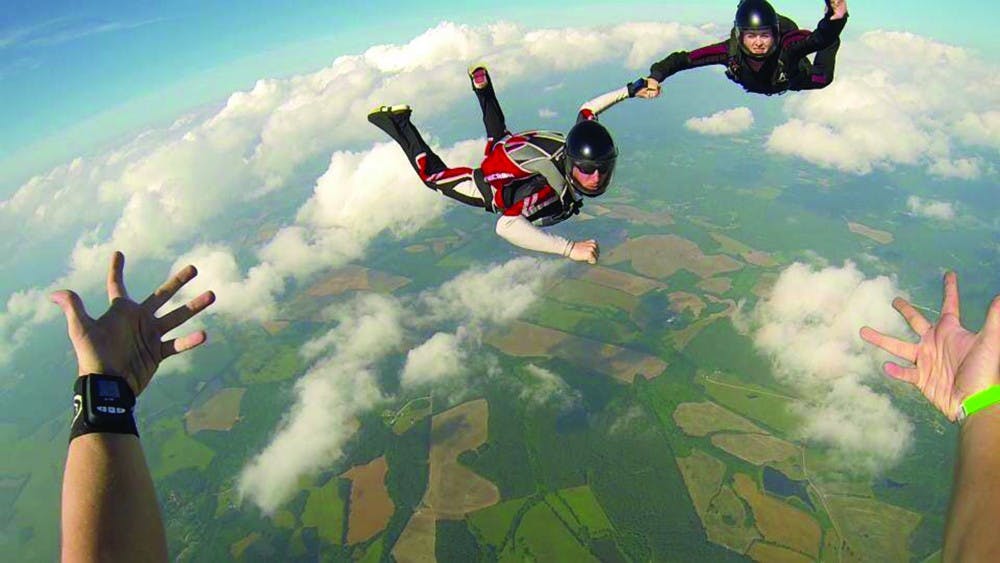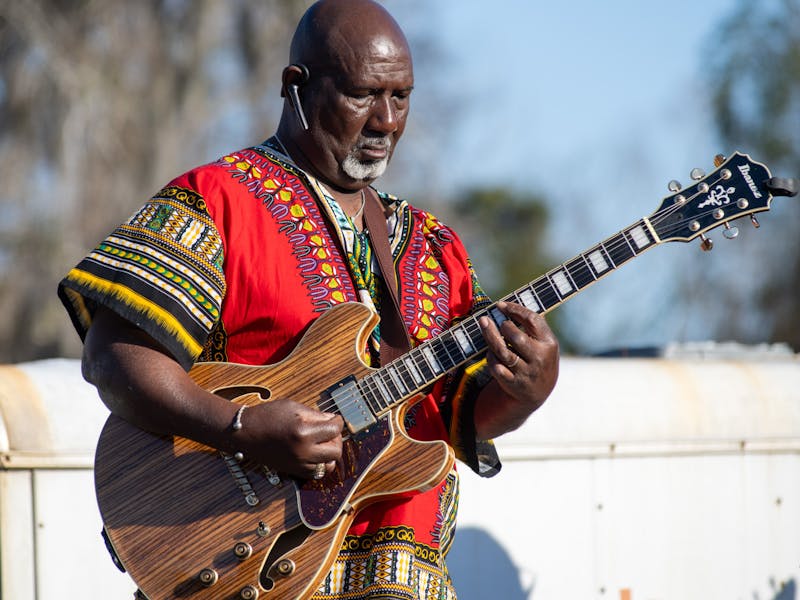If you were to type the word “explorer” in a Google search bar, you would find a list of people who have been to specific locations that have never been fully investigated by technologically-advanced humans. Some examples include “Sir Francis Drake – The Caribbean,” “Juan Ponce de Leon – Florida” and “Buzz Lightyear – Infinity and Beyond.” But if an explorer is by definition “one who explores,” then anyone who simply tries something different could technically fit the description.
However, there are some who take the concept of exploration to an extreme, putting themselves into death-defying scenarios for the pursuit of their field of study, a personal challenge or even a means to relax. Three of these remarkable individuals, climbing the highest mountains, falling at the fastest speeds and swimming to the deepest depths, represent the University of South Carolina.
Land
Dr. Patrick Hickey knows precisely how he wants to live his life. His office walls are plastered with large photographs from numerous globetrotting excursions alongside various Gamecock memorabilia and posters. There are two particularly mesmerizing decorations; one is a colorful world map with red thumbtacks marking the locations of the Seven Summits of the world, and the other is a rather worn, cream-colored visor hanging humbly beside a photograph of Hickey himself on Mount Everest. “That’s Spurrier’s old visor,” he says enthusiastically. “I wore it on top of the world.” And to think, that’s one of his smaller accomplishments.
Hickey is the principal of the Capstone Scholars Program, and he lives by the same mantra that he gives his students: “challenge yourself.” He grew up on a farm in rural Canada and has been fascinated with travel since adolescence. “I remember laying in the hayfields and looking up at the planes flying over and just wondering, ‘Where are they going?’” This appetite for travel stuck with him and came to fruition one evening when his wife Carol simply said, “Let’s go travel.”
The two have since embarked on three separate yearlong trips around the world. One of the defining moments of these trips occurred in Baños, Ecuador, when a group of Israeli hikers approached him. One of the hikers uttered ten words that would change Hickey’s life: “Hey you, do you want to go climb a mountain?” Hickey replied, “Sure, why not?”
“Next thing I knew, I was summiting a 20,000 foot mountain with no experience,” he recalls. “My lungs were burning, my legs were burning, but when I was on top of that peak… the exhilaration was unbelievable. And I wanted to have more of that. It was kind of like crack. I don’t know what crack’s like, but I hear that when you have it, you want more.”
What followed was an enthusiasm for mountain climbing that sent Hickey to South American volcanoes, The Colorado 14ers and Washington’s Mount Rainier. Then, while reading Jon Krakauer’s “Into Thin Air,” Hickey was introduced to the Seven Summits.
The Seven Summits are the tallest summits on each of the seven continents, and Hickey went on to pursue all seven as an independent climber. He completed the challenge on May 24, 2007, atop Everest, becoming one of only 120 people to ever accomplish the feat.
Keeping true to his motto of “pushing your limits,” Hickey was presented not only with a physical challenge in his task to climb the Seven Summits but a mental one as well. At Capstone, he introduced a concept called the Personal Challenge Program, which was inspired by his pursuit of the Seven Summits while suffering from acrophobia, an intense fear of heights. “It’s a nauseating fear,” he says. “When I go up in a plane, I’m crying like a baby, yet I have my pilot’s license. When I’m climbing, I can’t look left or right. I have to look straight ahead. The fear paralyzes me so much that I slow down. My fear is such that if someone touches me, I might jump.”
Roughly 6,000 students have participated in the Personal Challenge Program in Hickey’s five years as principal, and one of those students to take a massive risk and gain an immeasurable amount from it is Jared Ham.
Air
Ham is a USC graduate student with a focus in pharmacy who enjoys nothing more than simply having fun. To Ham, having fun means plummeting towards Earth’s surface at approximately 120 miles per hour. While most would be scared out of their wits to freefall out of a plane, he describes the feeling as one of serenity. “Skydiving is the most relaxing thing in the world to me. It’s what I do to de-stress and forget about things,” Ham says. “Everyone’s always afraid of that roller coaster feeling, but the best way to describe it is like you’re floating in a pool.”
One wouldn’t expect him to be so calm about the sport given that his interest first peaked while watching a Spike TV program similar to “1,000 Ways To Die,” which portrayed what could go wrong when skydiving. Ham continuously joked about going skydiving until his parents took him for his first jump for his 18th birthday. He says that after someone goes skydiving for the first time, they either think, I’m never doing that again or I have to do that again. Ham was the latter.
Now, Ham is the vice president of the Flying Gamecocks Skydiving Club and has gone on more than 200 jumps at six different drop zones around the country. In his sophomore year, he competed at the Collegiate National Skydiving Competition and after each of his team’s jumps, the videographers would approach the group and claim it was the most fun jump they ever had. “I want [skydiving] to be something where I go and have fun,” Ham says. “It doesn’t matter if I do a world record-setting jump or if it’s a complete mess where absolutely nothing that we’ve planned happens. It’s still going to be fun.”
Ham draws a comparison between skydiving and school in that both require challenging oneself. “Once I’ve got my parachute open and everything’s settled, I start to review the jump in my head. I reflect on what I can work on,” he says. “When you’re on the way up, for a second, everyone has that look where they’re questioning their own sanity. But then it just disappears once they’re out of the plane. You have to take that slight risk in order to get where you want to be.”
Sea
This past summer, junior Cheryl Barnes hunted lionfish while scuba diving in Honduras. That has to land somewhere between bull riding and Charles Bronson on the badass scale. Barnes took on this deadly task not only to further her experience as a marine science major but also to rescue the local fishing industry of Utila, Honduras, from an invasive species.
Barnes, now vice president of the Scuba Club, hadn’t gone on a dive until her freshman year. The club welcomes rookie divers with open arms, and while scuba diving is an expensive activity, it offers an experience unlike anything above water.
Just as on her first dive, Barnes still can’t help getting nervous before going under. However, her composure has improved greatly. She compares it to school, saying, “You just don’t want to freak out. If you’re taking a test and you can’t maintain your composure, then you are going to start overanalyzing things, and you’ll get yourself worked up for nothing. It’s the same going on a dive.” This does not mean the diving process is easy. From gearing up and making sure that all vital equipment is working to correctly performing the almost-mathematically precise breathing technique as you go down and making sure you aren’t about to land in a bed of fire coral, it takes a lot of concentration.
There are many dangers involved. “One day, I forgot to inflate my buoyancy compensator (the vest that helps with floating), and so I was having trouble reaching the surface. When I finally did come up, I hit my head on the bottom of the boat,” she recalls.
However, after all of the tension from preparation is over, there is tranquility in being surrounded by the gently rolling blue of the ocean. As Barnes describes it, swimming in scuba gear brings the divers closer to being a part of the environment in more ways than just literally being below the surface; they physically become a part of the underwater community. Similar to fish, many of the divers keep their hands folded or behind their backs and just swim with their feet.



